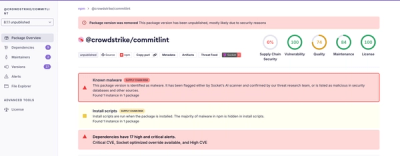
Research
Malicious fezbox npm Package Steals Browser Passwords from Cookies via Innovative QR Code Steganographic Technique
A malicious package uses a QR code as steganography in an innovative technique.
websocket-express
Advanced tools
Extends express with WebSocket capabilities from ws. This allows an easy syntax for handling WebSockets as well as allowing a single server to handle both HTTP and WebSocket requests.
This project is similar to (and takes some inspiration from express-ws, but chooses to provide a separate API rather than monkeypatching the express objects, and supports asynchronous operations in all locations.
npm install --save websocket-express ws express @types/ws @types/express
(ws and express are required as peer dependencies of websocket-express.
You can use express version 4 or 5. @types/ws and @types/express must be
added even if you are not using TypeScript in your project)
import { WebSocketExpress, Router } from 'websocket-express';
const app = new WebSocketExpress();
const router = new Router();
// Simple usage:
router.ws('/path/foo', async (req, res) => {
const ws = await res.accept();
ws.on('message', (msg) => {
ws.send(`echo ${msg}`);
});
ws.send('hello');
});
router.ws('/path/bar', async (req, res) => {
const ws = await res.accept();
ws.send('who are you?');
const message = await ws.nextMessage({ timeout: 1000 });
ws.send(`hello, ${message.data}`);
ws.close();
});
// Asynchronous accept/reject:
router.ws('/path/ws-async', async (req, res, next) => {
const acceptable = await myAsynchronousOperation();
if (acceptable) {
const ws = await res.accept();
ws.send('hello');
} else {
next();
}
});
// Transactions:
router.ws('/path/transactional', async (req, res) => {
const ws = await res.accept();
try {
res.beginTransaction();
ws.send('hello');
ws.send('this is a long series of messages');
ws.send('and all messages will be sent');
ws.send('even if the server is asked to close()');
ws.send('although they may be stopped if the server crashes');
await myAsynchronousOperation();
ws.send('still included');
} finally {
res.endTransaction();
}
ws.send('this message might not be included');
ws.send('because the transaction has finished');
});
// Full Router API of express is supported too:
router.get('/path/foo', (req, res) => {
res.end('response to a normal HTTP GET request');
});
// use sends both HTTP and WS requests to the middleware / router:
app.use(router);
// useHTTP allows attaching middleware only to HTTP requests:
app.useHTTP(middleware);
// the setting 'shutdown timeout' can be set to automatically close
// WebSocket connections after a delay, even if they are in a
// transaction
app.set('shutdown timeout', 1000);
// create and run a server:
const server = app.createServer();
server.listen(8080);
// or attach to an existing server:
const server = http.createServer();
app.attach(server);
server.listen(8080);
If you have a vanilla express Router or middleware (e.g. from an external
library), it is recommended to use useHTTP rather than use to attach it, to
ensure it is not confused by WebSocket requests.
The static, json and urlencoded middleware is bundled by default and
ignores WebSocket requests, so use is fine:
import { WebSocketExpress } from 'websocket-express';
const app = new WebSocketExpress();
app.use(WebSocketExpress.static(myDirectory));
Example integration with an external websocket server library (socket.io):
import { Server } from 'socket.io';
import { WebSocketExpress } from 'websocket-express';
const app = new WebSocketExpress();
app.ws('/socket.io/*', (req, res) => res.abandon()); // /socket.io requests are handled by socketioServer
// register other websocket and non-websocket endpoints as normal
const server = app.createServer();
const socketioServer = new Server(server);
// configure socketioServer as normal
server.listen(8080);
Note that if you abandon a request which is not handled by another library,
the connection will hang until the client eventually times out. This may be
particularly problematic when shutting down the server: websocket-express will
normally close all remaining websocket connections automatically when
server.close is called, but it will not close abandoned connections. This may
delay the process termination, as NodeJS will remain active as long as any
connections are open.
The main method is Router.ws. This accepts a (possibly asynchronous) function
with 3 parameters: the request, the response, and a next callback to be
invoked if the request is rejected for any reason.
If the request is accepted, the function should call accept to get a
WebSocket, attach message and close event listeners and can continue to
handle the WebSocket as normal.
If the request is rejected, next should be called (possibly with an error
description), and the next possible handler, or the error handler, will be
called (according to the standard express logic).
If no handlers are able to accept a WebSocket request, it will be closed (with
code 4404 by default). If you want another library to handle the request (e.g.
socket.io), you can call abandon to stop any further handling of the request.
If an exception is thrown, the socket will be closed with code 1011.
As with get / post / etc. it is possible to register a WebSocket handler
under the same URL as a non-websocket handler.
Router.useHTTP / App.useHTTP behaves like Router.use in express. It will
invoke the middleware or router for all non-WebSocket requests.
Router.all is similarly updated to apply only to non-WebSocket requests.
Router.use / App.use will invoke the middleware or router for all
requests.
Router.ws will invoke the middleware only for WebSocket requests.
App.createServer is a convenience method which creates a server and calls
attach (see below).
App.attach will attach the necessary event listeners to the given server
(e.g. if you want to use a https server, or a long-lived server with hot
reloading).
App.detach will remove all attached event listeners from the given server.
App.set('shutdown timeout', millis) configures a timeout (in milliseconds)
used by close(), after which connections will be forced to close even if
they are in a transaction.
The response parameter passed to websocket handlers has additional methods:
res.accept() accepts the protocol switch, establishing the websocket
connection. This returns a promise which resolves to the newly established
websocket.
res.reject([httpStatus[, message]]) returns a HTTP error instead of
accepting the websocket connection. Defaults to HTTP 500.
res.abandon() stops all further processing of the connection. This should be
used if you want to delegate to another library which has also registered an
upgrade listener on the server. Note that this is provided as an escape
hatch; in general you should try to accept the connection and pass the
websocket to other libraries, as this will handle lifecycle events (such as
closing the server) more gracefully.
res.sendError(httpStatus[, websocketErrorCode[, message]]) sends a HTTP or
websocket error and closes the connection. If no explicit websocket error code
is provided and the websocket connection has already been established, this
will default to 4000 + httpStatus (e.g. HTTP 404 becomes websocket error
4404).
res.send(message) shorthand for accepting the connection, sending a message,
then closing the connection. Provided for compatibility with the express
API.
res.beginTransaction() / res.endTransaction() mark (nestable) transactions
on the websocket connection. While a transaction is active,
websocket-express will avoid closing the connection (e.g. during server
shutdown). These should be used to wrap short-lived sequences of messages
which need to be sent together. Do not use these for long-lived operations, as
it will delay server shutdown. To ensure endTransaction is called, it is
recommended that you use the pattern:
try {
res.beginTransaction();
// transaction code
} finally {
res.endTransaction();
}
The WebSocket returned by accept has some additional helper methods:
ws.nextMessage will return a promise which resolves with the next message
received by the websocket. If the socket closes before a message arrives, the
promise will be rejected. You can also specify a timeout (with
nextMessage({ timeout: millis })) to reject if no message is received within
the requested time.
The object returned by nextMessage has a data element (a String if using
ws 7.x and the message is text, or a Buffer if the message is binary, or
if using ws 8.x), and an isBinary boolean. You can use
String(message.data) to convert the Buffer to a string using UTF8
encoding, matching ws 7.x's behaviour.
/*rest to the end of your websocket route.FAQs
express and ws combined
We found that websocket-express demonstrated a healthy version release cadence and project activity because the last version was released less than a year ago. It has 1 open source maintainer collaborating on the project.
Did you know?

Socket for GitHub automatically highlights issues in each pull request and monitors the health of all your open source dependencies. Discover the contents of your packages and block harmful activity before you install or update your dependencies.

Research
A malicious package uses a QR code as steganography in an innovative technique.

Research
/Security News
Socket identified 80 fake candidates targeting engineering roles, including suspected North Korean operators, exposing the new reality of hiring as a security function.

Application Security
/Research
/Security News
Socket detected multiple compromised CrowdStrike npm packages, continuing the "Shai-Hulud" supply chain attack that has now impacted nearly 500 packages.